C# Scale the size of bubble chart on the presentation slides
We have already shown how to use Spire.Presentation to create the bubble chart in C# on the PowerPoint document. This article will demonstrate how to scale the size of bubble chart on the presentation slides in C#. We will use a 3-D bubble chart for example.
Step 1: Create a Presentation instance and load a sample document from the file.
Presentation ppt = new Presentation();
ppt.LoadFromFile("Sample.pptx", FileFormat.Pptx2010);
Step 2: Get the chart from the first presentation slide.
IChart chart = ppt.Slides[0].Shapes[0] as IChart;
Step 3: Scale the bubble size, the range value is from 0 to 300.
chart.BubbleScale = 50;
Step 4: Save the document to file.
ppt.SaveToFile("Scalesize.pptx", FileFormat.Pptx2010);
Effective screenshot of scale the bubble size:
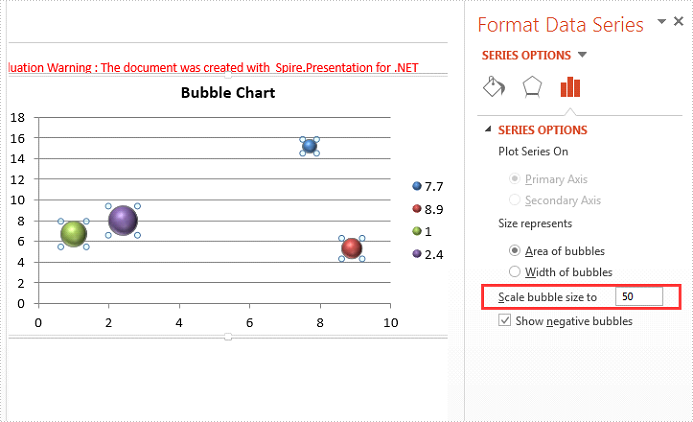
Full codes:
using Spire.Presentation;
using Spire.Presentation.Charts;
namespace ScaleSize
{
class Program
{
static void Main(string[] args)
{
Presentation ppt = new Presentation();
ppt.LoadFromFile("Sample.pptx", FileFormat.Pptx2010);
IChart chart = ppt.Slides[0].Shapes[0] as IChart;
chart.BubbleScale = 50;
ppt.SaveToFile("Scalesize.pptx", FileFormat.Pptx2010);
}
}
}
Detect if a PDF file is PDF/A in C#
Spire.PDF provides developers two methods to detect if a PDF file is PDF/A. The one is to use PdfDocument.Conformance property, the other is to use PdfDocument.XmpMetaData property. The following examples demonstrate how we can detect if a PDF file is PDF/A using these two methods.
Below is the screenshot of the sample file we used for demonstration:

Using PdfDocument.Conformance
using Spire.Pdf;
using System;
namespace Detect
{
class Program
{
static void Main(string[] args)
{
//Initialize a PdfDocument object
PdfDocument pdf = new PdfDocument();
//Load the PDF file
pdf.LoadFromFile("Example.pdf");
//Get the conformance level of the PDF file
PdfConformanceLevel conformance = pdf.Conformance;
Console.WriteLine("This PDF file is " + conformance.ToString());
}
}
}
Output:
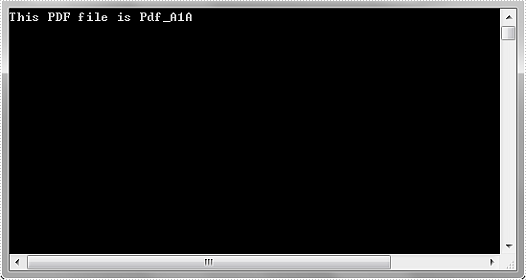
Using PdfDocument.XmpMetaData
using Spire.Pdf;
using Spire.Pdf.Xmp;
using System;
using System.Xml;
namespace Detect
{
class Program
{
static void Main(string[] args)
{
//Initialize a PdfDocument object
PdfDocument pdf = new PdfDocument();
//Load the PDF file
pdf.LoadFromFile("Example.pdf");
//Get the XMP MetaData of the file
XmpMetadata xmpData = pdf.XmpMetaData;
//Get the XMP MetaData in XML format
XmlDocument xmlData = xmpData.XmlData;
string s = xmlData.InnerXml;
Console.WriteLine(s);
}
}
}
Output:
From the following output, we can see there is an XML tag named pdfaid:part and another XML tag named pdfaid:conformance. The PDF/A specification indicates that pdfaid:part references the PDF/A version identifier, and pdfaid:conformance references the PDF/A conformance level (A or B in case of PDF/A-1). In this example, the PDF/A version is 1 and the PDF/A conformance level is A. That is to say, this file is PDF/A-1a.

C# Activate a Worksheet
Activate a worksheet means clicking the worksheet's tab on MS Excel. Usually when we open the Excel workbook, it goes to the worksheet when we closed last time. With Spire.XLS, we can set a worksheet as active sheet in the workbook by using the sheet.Activate() method. Then when we open the excel workbook next time, it goes to the activate worksheet we set.
C# Code Snippet of how to activate a worksheet:
Step 1: Create an instance of Excel workbook and load the document from file.
Workbook workbook = new Workbook();
workbook.LoadFromFile("Sample.xlsx");
Step 2: Get the second worksheet from the workbook.
Worksheet sheet = workbook.Worksheets[1];
Step 3: Activate the sheet.
sheet.Activate();
Step 4: Save the document to file.
workbook.SaveToFile("result.xlsx",FileFormat.Version2013);
Full codes:
using Spire.Xls;
namespace ActivateWorksheet
{
class Program
{
static void Main(string[] args)
{
Workbook workbook = new Workbook();
workbook.LoadFromFile("Sample.xlsx");
Worksheet sheet = workbook.Worksheets[1];
sheet.Activate();
workbook.SaveToFile("result.xlsx", FileFormat.Version2013);
}
}
}
Create an Image Hyperlink in Word in C#, VB.NET
With linked images, you can direct users to a URL when they click the image. This article will show you how to create image hyperlinks in a Word document by using Spire.Doc.
Step 1: Create a Word document, add a section and a paragraph.
Document doc = new Document(); Section section = doc.AddSection(); Paragraph paragraph = section.AddParagraph();
Step 2: Load an image to a DocPicture object.
DocPicture picture = new DocPicture(doc);
picture.LoadImage(Image.FromFile("logo.png"));
Step 3: Add an image hyperlink to the paragraph.
paragraph.AppendHyperlink("www.e-iceblue.com", picture, HyperlinkType.WebLink);
Step 4: Save the file.
doc.SaveToFile("output.docx", FileFormat.Docx);
Output:
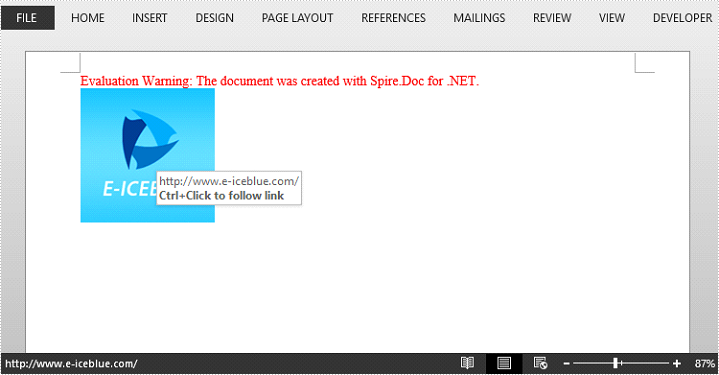
Full Code:
using Spire.Doc;
using Spire.Doc.Documents;
using Spire.Doc.Fields;
using System.Drawing;
namespace CreateLink
{
class Program
{
static void Main(string[] args)
{
Document doc = new Document();
Section section = doc.AddSection();
Paragraph paragraph = section.AddParagraph();
Image image = Image.FromFile("logo.png");
DocPicture picture = new DocPicture(doc);
picture.LoadImage(image);
paragraph.AppendHyperlink("www.e-iceblue.com", picture, HyperlinkType.WebLink);
doc.SaveToFile("output.docx", FileFormat.Docx);
}
}
}
Imports Spire.Doc
Imports Spire.Doc.Documents
Imports Spire.Doc.Fields
Imports System.Drawing
Namespace CreateLink
Class Program
Private Shared Sub Main(args As String())
Dim doc As New Document()
Dim section As Section = doc.AddSection()
Dim paragraph As Paragraph = section.AddParagraph()
Dim image__1 As Image = Image.FromFile("logo.png")
Dim picture As New DocPicture(doc)
picture.LoadImage(image__1)
paragraph.AppendHyperlink("www.e-iceblue.com", picture, HyperlinkType.WebLink)
doc.SaveToFile("output.docx", FileFormat.Docx)
End Sub
End Class
End Namespace
Get Text within a Bookmark in C#, VB.NET
Spire.Doc supports to retrieve, replace and delete bookmark content of a specified bookmark. This article will show you how we can get the plain text within a bookmark by using Spire.Doc with C# and VB.NET.
Step 1: Create a Document instance, and load a sample Word document.
Document doc = new Document();
doc.LoadFromFile("Bookmark.docx");
Step 2: Creates a BookmarkNavigator instance to access the bookmark.
BookmarksNavigator navigator = new BookmarksNavigator(doc);
Step 3: Locate a specific bookmark by bookmark name. Call the method GetBookmarkContent to get content within the bookmark.
navigator.MoveToBookmark("bookmark_1");
TextBodyPart textBodyPart = navigator.GetBookmarkContent();
Step 4: Iterate through the items in the bookmark content to get the plain, unformatted text of the bookmark.
string text = null;
foreach (var item in textBodyPart.BodyItems)
{
if (item is Paragraph)
{
foreach (var childObject in (item as Paragraph).ChildObjects)
{
if (childObject is TextRange)
{
text += (childObject as TextRange).Text;
}
}
}
}
Result:
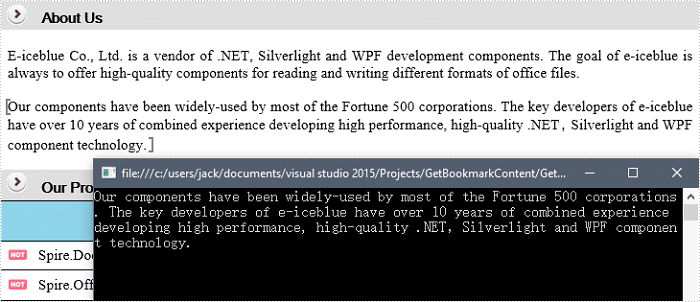
Full Code:
using Spire.Doc;
using Spire.Doc.Documents;
using Spire.Doc.Fields;
using System;
namespace GetText
{
class Program
{
static void Main(string[] args)
{
Document doc = new Document();
doc.LoadFromFile("Bookmark.docx");
BookmarksNavigator navigator = new BookmarksNavigator(doc);
navigator.MoveToBookmark("bookmark_1");
TextBodyPart textBodyPart = navigator.GetBookmarkContent();
string text = null;
foreach (var item in textBodyPart.BodyItems)
{
if (item is Paragraph)
{
foreach (var childObject in (item as Paragraph).ChildObjects)
{
if (childObject is TextRange)
{
text += (childObject as TextRange).Text;
}
}
}
}
Console.WriteLine(text);
}
}
}
Imports Spire.Doc
Imports Spire.Doc.Documents
Imports Spire.Doc.Fields
Namespace GetText
Class Program
Private Shared Sub Main(args As String())
Dim doc As New Document()
doc.LoadFromFile("Bookmark.docx")
Dim navigator As New BookmarksNavigator(doc)
navigator.MoveToBookmark("bookmark_1")
Dim textBodyPart As TextBodyPart = navigator.GetBookmarkContent()
Dim text As String = Nothing
For Each item As var In textBodyPart.BodyItems
If TypeOf item Is Paragraph Then
For Each childObject As var In TryCast(item, Paragraph).ChildObjects
If TypeOf childObject Is TextRange Then
text += TryCast(childObject, TextRange).Text
End If
Next
End If
Next
Console.WriteLine(text)
End Sub
End Class
End Namespace
Delete shapes in an Excel Worksheet in C#
Spire.XLS supports to delete a specific shape as well as all shapes in an Excel worksheet. This article demonstrates how to use Spire.XLS to implement this function.
The example file we used for demonstration:

Detail steps:
Step 1: Initialize an object of Workbook class and load the Excel file.
Workbook workbook = new Workbook();
workbook.LoadFromFile("Input.xlsx");
Step 2: Get the first worksheet.
Worksheet sheet = workbook.Worksheets[0];
Step 3: Delete the first shape in the worksheet.
sheet.PrstGeomShapes[0].Remove();
To delete all shapes from the worksheet:
for (int i = sheet.PrstGeomShapes.Count-1; i >= 0; i--)
{
sheet.PrstGeomShapes[i].Remove();
}
Step 4: Save the file.
workbook.SaveToFile("DeleteShape.xlsx", ExcelVersion.Version2013);
Screenshot:

Full code:
using Spire.Xls;
namespace DeleteShape
{
class Program
{
static void Main(string[] args)
{
//Initialize an object of Workbook class
Workbook workbook = new Workbook();
//Load the Excel file
workbook.LoadFromFile("Input.xlsx");
//Get the first worksheet
Worksheet sheet = workbook.Worksheets[0];
//Delete the first shape in the worksheet
sheet.PrstGeomShapes[0].Remove();
//Delete all shapes in the worksheet
//for (int i = sheet.PrstGeomShapes.Count-1; i >= 0; i--)
//{
// sheet.PrstGeomShapes[i].Remove();
//}
workbook.SaveToFile("DeleteShape.xlsx", ExcelVersion.Version2013);
}
}
}
Set the border type and color for the table on Presentation slides
With the help of Spire.Presentation, we can easily set the border type and color of a whole table on the presentation slides. This article will focus on demonstrating how to set the border for the table in C#.
Firstly, view the 12 border types for the table on PowerPoint file:
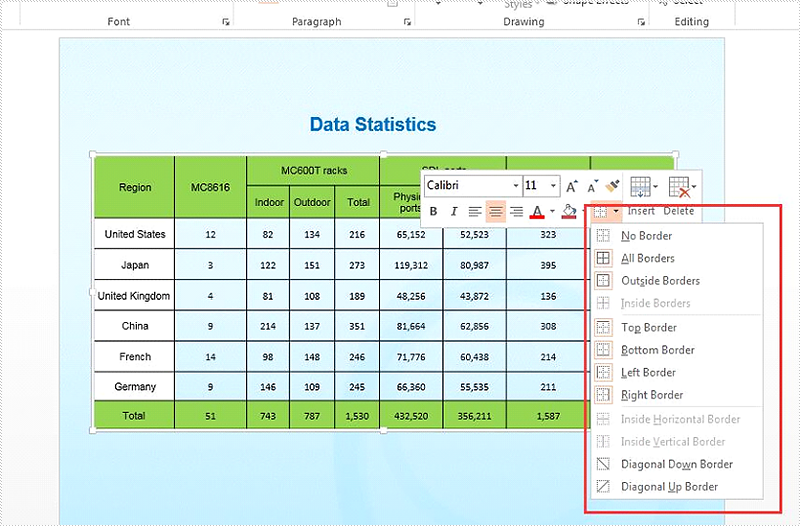
How to set the border type and color for an existing table on presentation slide:
//create a presentation document and load the file from disk
Presentation presentation = new Presentation();
presentation.LoadFromFile("Sample.pptx");
//get the table from the first slide of the sample document
ISlide slide = presentation.Slides[0];
ITable table = slide.Shapes[1] as ITable;
//set the border type as Inside and the border color as blue
table.SetTableBorder(TableBorderType.Inside, 1, Color.Blue);
//save the document to file
presentation.SaveToFile("Insideborder.pptx", FileFormat.Pptx2010);
Effective screenshot after set the border type for an existing table on presentation slide:

How to set the border type and color for newly added tables on presentation slide:
using Spire.Presentation;
using System;
namespace Set_border_type_and_color
{
class Program
{
static void Main(string[] args)
{
//create a presentation document
Presentation presentation = new Presentation();
//set the table width and height for each table cell
double[] tableWidth = new double[] { 100, 100, 100, 100, 100 };
double[] tableHeight = new double[] { 20, 20 };
//traverse all the border type of the table
foreach (TableBorderType item in Enum.GetValues(typeof(TableBorderType)))
//add a table to the presentation slide with the setting width and height
{
ITable itable = presentation.Slides.Append().Shapes.AppendTable(100, 100, tableWidth, tableHeight);
//add some text to the table cell
itable.TableRows[0][0].TextFrame.Text = "Row";
itable.TableRows[1][0].TextFrame.Text = "Column";
//set the border type, border width and the border color for the table
itable.SetTableBorder(item, 1.5, Color.Red);
}
//save the document to file
presentation.SaveToFile("Addtablewithborder.pptx", FileFormat.Pptx2010);
}
}
}
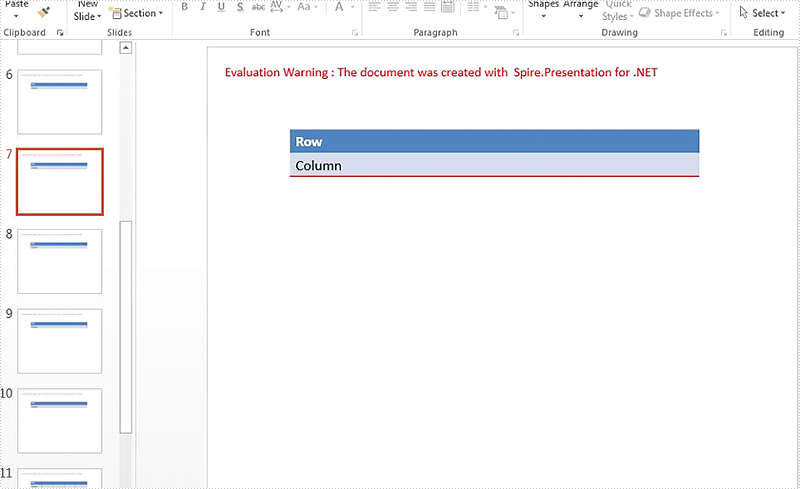
Retrieve Style Names of all TextRanges in a Word Document in C#, VB.NET
Programmers may need to determine the style name of a section of text, or find the text in a document that appear in a specified style name, such as “Heading 1”. This article will show you how to retrieve style names that are applied in a Word document by using Spire.Doc with C# and VB.NET.
Step 1: Create a Document instance.
Document doc = new Document();
Step 2: Load a sample Word file.
doc.LoadFromFile("Sample.docx");
Step 3: Traverse all TextRanges in the document and get their style names through StyleName property.
foreach (Section section in doc.Sections)
{
foreach (Paragraph paragraph in section.Paragraphs)
{
foreach (DocumentObject docObject in paragraph.ChildObjects)
{
if (docObject.DocumentObjectType == DocumentObjectType.TextRange)
{
TextRange text = docObject as TextRange;
Console.WriteLine(text.StyleName);
}
}
}
}
Result:
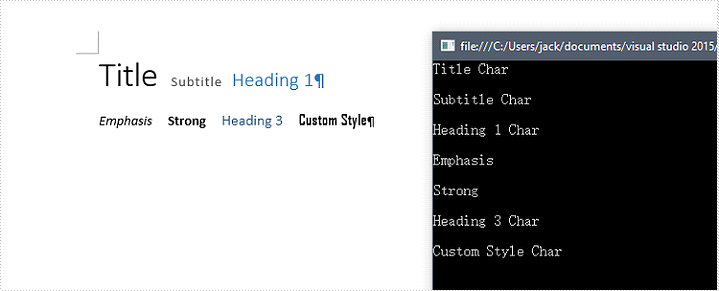
Full Code:
using Spire.Doc;
using Spire.Doc.Documents;
using Spire.Doc.Fields;
using System;
using System.Text.RegularExpressions;
namespace RetrieveStyleNames
{
class Program
{
static void Main(string[] args)
{
Document doc = new Document();
doc.LoadFromFile("Sample.docx");
foreach (Section section in doc.Sections)
{
foreach (Paragraph paragraph in section.Paragraphs)
{
foreach (DocumentObject docObject in paragraph.ChildObjects)
{
if (docObject.DocumentObjectType == DocumentObjectType.TextRange)
{
TextRange text = docObject as TextRange;
Console.WriteLine(text.StyleName);
}
}
Console.WriteLine();
}
}
}
}
}
Imports Spire.Doc
Imports Spire.Doc.Documents
Imports Spire.Doc.Fields
Imports System.Text.RegularExpressions
Namespace RetrieveStyleNames
Class Program
Private Shared Sub Main(args As String())
Dim doc As New Document()
doc.LoadFromFile("Sample.docx")
For Each section As Section In doc.Sections
For Each paragraph As Paragraph In section.Paragraphs
For Each docObject As DocumentObject In paragraph.ChildObjects
If docObject.DocumentObjectType = DocumentObjectType.TextRange Then
Dim text As TextRange = TryCast(docObject, TextRange)
Console.WriteLine(text.StyleName)
End If
Next
Console.WriteLine()
Next
Next
End Sub
End Class
End Namespace
How to reset the position of the date time and slide number for the presentation slides
We have already demonstrated whether to display the additional information for presentation slides on header and footer area, such as hide or display date and time, the slide number, and the footer with the help of Spire.Presentation. This article will show you how to reset the position of the slide number and the date time in C#. We will also demonstrate how to reset the display format for the date and time from MM/dd/yyyy to yy.MM.yyyy on the presentation slides.
Firstly, view the default position of the date time at the left and the slide number at the right.

Step 1: Create a presentation document and load the file from disk.
Presentation presentation = new Presentation();
presentation.LoadFromFile("Sample.pptx", FileFormat.Pptx2013);
Step 2: Get the first slide from the sample document.
ISlide slide = presentation.Slides[0];
Step 3: Reset the position of the slide number to the left and date time to the center, and reset the date time display style.
foreach (IShape shapeToMove in slide.Shapes)
{
if (shapeToMove.Name.Contains("Slide Number Placeholder"))
{
shapeToMove.Left =0;
}
else if (shapeToMove.Name.Contains("Date Placeholder"))
{
shapeToMove.Left = presentation.SlideSize.Size.Width / 2;
(shapeToMove as IAutoShape).TextFrame.TextRange.Paragraph.Text = DateTime.Now.ToString("dd.MM.yyyy");
(shapeToMove as IAutoShape).TextFrame.IsCentered = true;
}
}
Step 4: Save the document to file.
presentation.SaveToFile("Result.pptx", FileFormat.Pptx2013);
Effective screenshot after reset the position and the format for the date time and slide number.
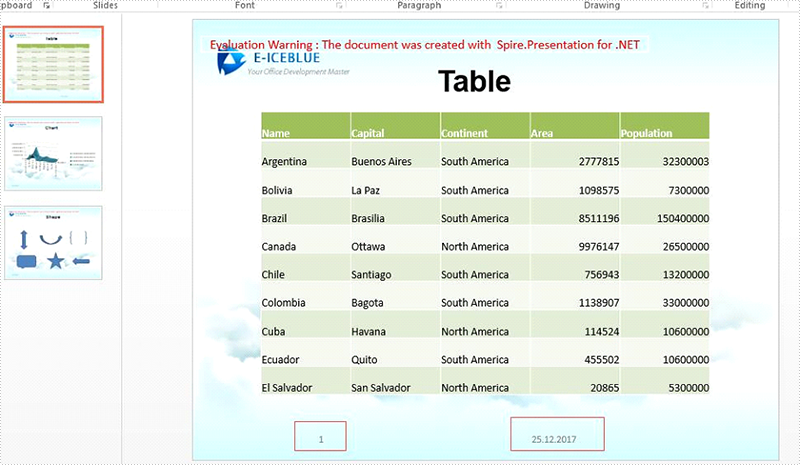
Full codes of how to reset the position of slide number and date time:
using Spire.Presentation;
using System;
namespace ResetPosition
{
class Program
{
static void Main(string[] args)
{
Presentation presentation = new Presentation();
presentation.LoadFromFile("Sample.pptx", Spire.Presentation.FileFormat.Pptx2013);
ISlide slide = presentation.Slides[0];
foreach (IShape shapeToMove in slide.Shapes)
{
if (shapeToMove.Name.Contains("Slide Number Placeholder"))
{
shapeToMove.Left = 0;
}
else if (shapeToMove.Name.Contains("Date Placeholder"))
{
shapeToMove.Left = presentation.SlideSize.Size.Width / 2;
(shapeToMove as IAutoShape).TextFrame.TextRange.Paragraph.Text = DateTime.Now.ToString("dd.MM.yyyy");
(shapeToMove as IAutoShape).TextFrame.IsCentered = true;
}
}
presentation.SaveToFile("Result.pptx", Spire.Presentation.FileFormat.Pptx2013);
}
}
}
C#/VB.NET: Highlight Top and Bottom Ranked Values in Excel
Searching for high or low values in large amounts of data can be cumbersome and error-prone. Fortunately, in Excel, you can apply conditional formatting to quickly highlight a specified number of top or bottom ranked values in a selected cell range. In this article, you will learn how to programmatically highlight top and bottom values in Excel using Spire.XLS for .NET.
Install Spire.XLS for .NET
To begin with, you need to add the DLL files included in the Spire.XLS for .NET package as references in your .NET project. The DLL files can be either downloaded from this link or installed via NuGet.
PM> Install-Package Spire.XLS
Highlight Top and Bottom Values in Excel in C# and VB.NET
Spire.XLS for .NET provides the XlsConditionalFormats.AddTopBottomCondition(TopBottomType topBottomType, int rank) method to specify the top N or bottom N ranked values, and then you can highlight these values with a background color. The following are the detailed steps.
- Create a Workbook instance.
- Load a sample Excel document using Workbook.LoadFromFile() method.
- Get a specified worksheet by its index using Workbook.Worksheets[sheetIndex] property.
- Add a conditional formatting to the worksheet using Worksheet.ConditionalFormats.Add() method and return an object of XlsConditionalFormats class.
- Set the cell range where the conditional formatting will be applied using XlsConditionalFormats.AddRange() method.
- Add a top condition to specify the highest or top N ranked values using XlsConditionalFormats.AddTopBottomCondition(TopBottomType topBottomType, int rank) method. Then highlight the cells that meet the condition with a background color using IConditionalFormat.BackColor property.
- Add a bottom condition to specify the lowest or bottom N ranked values and highlight the cells that meet the condition with a background color.
- Save the result document using Workbook.SaveToFile() method.
- C#
- VB.NET
using Spire.Xls;
using Spire.Xls.Core;
using Spire.Xls.Core.Spreadsheet.Collections;
using System.Drawing;
namespace HighlightValues
{
class Program
{
static void Main(string[] args)
{
{
//Create a Workbook instance
Workbook workbook = new Workbook();
//Load a sample Excel document
workbook.LoadFromFile("sample.xlsx");
//Get the first worksheet
Worksheet sheet = workbook.Worksheets[0];
//Add a conditional format to the worksheet
XlsConditionalFormats format = sheet.ConditionalFormats.Add();
//Set the range where the conditional format will be applied
format.AddRange(sheet.Range["B2:F7"]);
//Apply conditional formatting to highlight the highest values
IConditionalFormat condition1 = format.AddTopBottomCondition(TopBottomType.Top, 1);
condition1.BackColor = Color.Red;
//Apply conditional formatting to highlight the bottom two values
IConditionalFormat condition2 = format.AddTopBottomCondition(TopBottomType.Bottom, 2);
condition2.BackColor = Color.ForestGreen;
//Save the result document
workbook.SaveToFile("TopBottomValues.xlsx", ExcelVersion.Version2013);
}
}
}
}
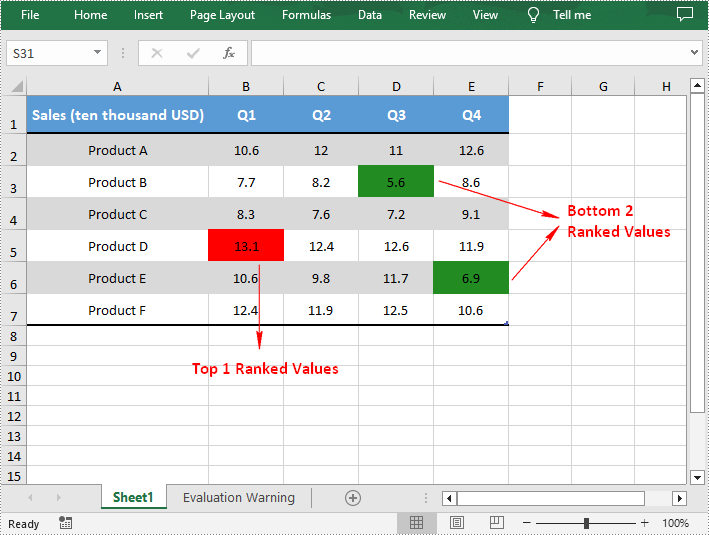
Apply for a Temporary License
If you'd like to remove the evaluation message from the generated documents, or to get rid of the function limitations, please request a 30-day trial license for yourself.